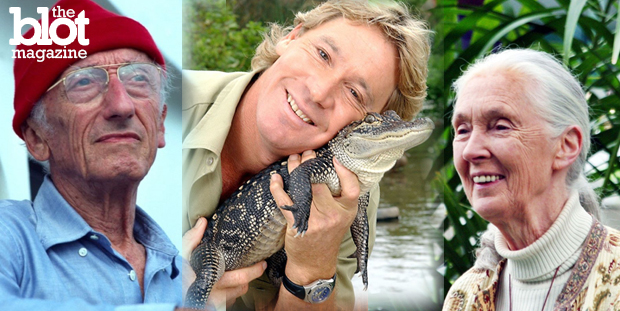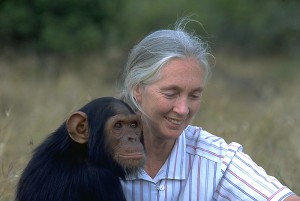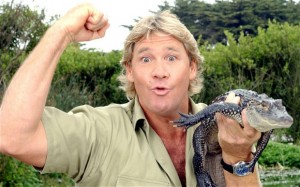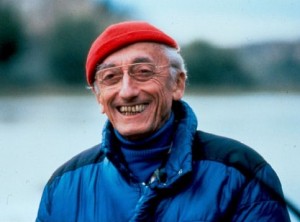While the death of Cecil the lion has brandished a much-needed spotlight into the dark and illicit world of trophy hunting, we should also use it as an opportunity to bring to light the amazing conservation efforts that are taking place all over the world each and every day.
Incredible individuals, such as Jane Goodall, the Irwin family, Jacques Cousteau and others have made it their mission in life to help save and protect endangered species and fragile ecosystems that, without their help, would have gone the way of Cecil and the countless others before him.
Take a look into the lives of those who have given their all for the sake of the planet and her residents.
Jane Goodall (1934-)
At 81 years of age, Dame Jane Morris Goodall is still a force to be reckoned with in the world of environmentalism and conservationism. Since 1958, she has been a fervent leader in primate research and is directly responsible for ground-breaking insight into chimpanzee behavior that rocked the scientific community in the early 1960s. Goodall observed chimpanzee’s using tools, showing affection and hostility toward one another, communication between primates and eating habits never before observed by researchers.
Her methods were deemed rather controversial; during her research, Goodall gave each chimp she was observing a name, rather than assigning them a number, which at the time was unheard of. She actually joined the troop of chimpanzees she was studying and lived among them for 22 months before being displaced by a dominate male. Again, her actions were considered controversial and criticized repeatedly, but without her unorthodox approach, who knows where we would be in our understanding one of our closest relatives?
Even today Jane Goodall is still making waves with her approach to conservation and animal rights. She has been instrumental in bringing much-needed awareness to the atrocities of factory farming, trophy hunting and the usage of airlines by laboratories to transport chimpanzees for medical experiments. She travels more than 300 days a year to promote environmental awareness, advocacy research and education. What will you be doing at age 81? I’ll be happy if I remember my name …
Steve Irwin (1962-2006)
While also known as “The Crocodile Hunter,” Steve Irwin’s love for all things on this Earth was beyond reproach, and his excitement for environmentalism was contagious at best. Irwin considered it his mission to save endangered species, and his life’s work proved it.
Between his years on Animal Planet’s “The Crocodile Hunter” which showcased not only Irwin’s croc-based shenanigans but his interactions with other species as well, his promotion of environmental awareness, numerous documentaries and his ground-breaking research at the Australia Zoo into crocodilean behavior, Steve truly invested all that he had into advocacy.
But his eagerness to save endangered species didn’t stop there. Irwin also purchased large tracts of land in Australia, Vanuatu, Fiji and the United States in an effort to have land available for animals to live on without the threat of encroachment, as well as have areas that were untouched where he could film programs to bring audiences on animal “adventures.”
As passionate as he was about animals, Steve Irwin was equally passionate about his family, who all share his love of animals and educating the public on environmental issues. Since his accidental death in 2006, when he was pierced in the chest by a stingray during the filming of an underwater documentary, his wife Terri and their children, Bindi Sue and Robert Clarence, have continued on with his conservation work and animal advocacy with an insurmountable amount of public support.
Jacques Cousteau (1910-1997)
Famed oceanographer, conservationist, photographer and author, Jacques Cousteau’s research and innovations in underwater swimming apparatuses are still used to this day, including open-circuit scuba technology.
He was the first to discover echolocation in porpoises, the first to develop underwater traveling vehicles to reach deep-water discoveries and the first to develop a more efficient breathing apparatus that allowed divers to stay below the surface for greater spans of time.
All of these discoveries were aimed to improve ocean research in an effort to understand the relationship between man, the ocean and the ecosystem beneath the waves. His 120 documentaries, 50 research books and namesake environmental protection foundation of more than 300,000 members has brought more attention, discovery and insight into the underwater world and our impact on its health than nearly any other ocean researcher has to date.
Jacques Cousteau’s grandson Fabien Cousteau has carried on his life’s work of conservation, education, oceanic research and advocacy by filming his own documentaries on the ocean’s most misunderstood inhabitants and starting nonprofit organizations such as Plant A Fish to help rebuild wild fish populations in areas like the Florida Keys and the Maldives. Fabien also spent 31 days underwater in the research lab Aquarius, in a tribute to his late grandfather, and bested Jacques’ 30-day record of staying in the ocean depths.
* * *
These are just a three of the hundreds of incredible people who have given so much to the cause of saving the planet’s most vulnerable species and habitats. Yet with all they have sacrificed, their work would mean nothing without support from everyday individuals who share a passion for the natural world but may not understand how it all works together.
That’s where naturalists and conservationists come in, to not only study the planet and its inhabitants, but to illuminate the ways that we are all connected together — and that what happens to one, happens to us all.
Diana Marsh is a contributing journalist for TheBlot Magazine.









